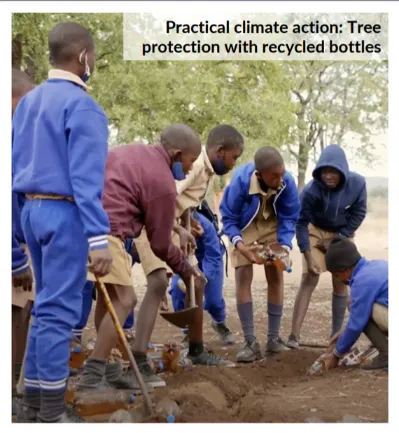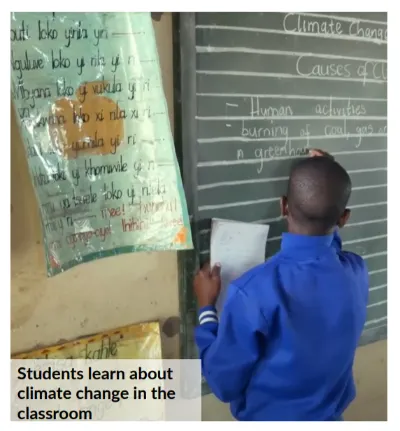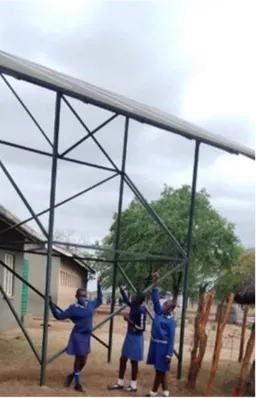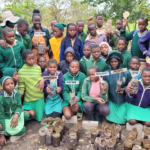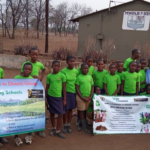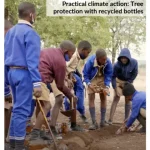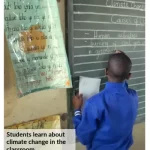Teacher: Edson Dongo
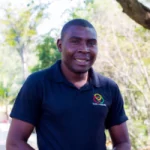
Edson Dongo
Edson is an experienced teacher, Alumni manager and Climate change lead at Teach for Zimbabwe with 10 years of experience. He started conservation and environmental clubs in schools educating learners and communities about environmental stewardship. This was motivated by the adverse effects of climate change affecting the local communities. Edson is now using this vast experience to collectively equip learners and communities with skills, tools and mindsets, thereby creating resilience. He is passionate about bringing climate change education to the learners and community at large. He presented his projects and work to local and international audiences including but not limited to; IRENA in Abu Dhabi, TeachersCOP, LearningPlanet, Schools and communities.
Usefull links related to the Solution
Overview
This is an example of how one primary school in Chiredzi District, Zimbabwe successfully took a whole school approach to climate change preparedness. Edson, a teacher at the school, developed a climate change programme and implemented it in the school. Teach for Zimbabwe (TFZ) became aware of the success of the programme, championed it, and is now rolling it out across the whole TFZ network of schools.
Theory of Change
Edson identified that there were lots of resources available for teaching climate change education, however, there was a skills, knowledge and mindset gap within the community and the school he taught in; despite resources being available, climate change education was failing. Edson believes that the community and school have a complex, intertwined relationship and both the school and community can act as a resource for each other, in this case in providing climate change education. In the project, every aspect of the school and teaching was designed to impart sustainable practices to all school stakeholders. The community interaction with the school also offered opportunities to ground climate change learning in the local context. Through effectively teaching climate change education the project aims to produce leaders who will have the knowledge and skills to affect positive change in the future.
Approach and Actions
The whole school approach targets four key focus areas- curriculum; policies; facilities and infrastructure; and community partnerships. Teaching and learning have been adapted to be project-based and to develop critical thinking; projects also involve real-life local issues. This teaching aims to reconnect learners to the local context and to empower them to act.
Local indigenous learning is incorporated into the climate change curriculum, ensuring learning is connected to local cultural and contextual knowledge. For example, learners are given the opportunity to compare historic and current practices at a local homestead which operates like a living museum. This experience helps students to think of new ways to solve local problems as well as demonstrating to learners their place within the natural environment. The curriculum is also mindful of the spiritual practices that have been part of local culture for millennia. Demonstrating links between climate change education and local spiritualism has helped change mindsets in the community, for example, the local chief attended a climate change education event during the project, this was seen as a big endorsement of the project and climate education more generally. Other local public and private sector stakeholders are now being encouraged to contribute to the project as environmental stewardship is seen as the responsibility of everyone in the community.
Mechanisms are in place which allow the whole school community to participate in school policy drafting. This has led to a shared sustainability vision across the school and community. The school buildings and infrastructure also function as an example of green building, demonstrating building techniques to the community.
Impact
There have been measured improvements in the sustainable behaviour of learners and businesses in the area, this has been directly attributed to the interventions put in place by (WSA). Learners have even been observed going to neighbouring schools to disseminate their knowledge of sustainable behaviour to other students. Introducing local indigenous learning into the curriculum has led to an increase in student participation, students are also more engaged by the new learning and by the practical way it is delivered. The project is currently being rolled out in more than 50 schools in three districts across the country.


